Cat Dental Care
Felines often suffer from disorders relating to the teeth, gums, jaw, and mouth. As an owner, it can be difficult to spot problems with cat teeth. This is because felines are very adept at masking signs of pain and discomfort. When trying to identify the signs of unhealthy cat teeth, the feline may continue to eat and drink as normal. However, cat gum disease can quickly progress if not addressed. The key to heading off problems is to focus on regular cat teeth cleaning. Proper cat dental care can help prevent costly cleanings at the vet and additional health issues.
Often, oral health concerns can cause considerable suffering, and a feline may become livelier and more content if an owner follows good cat dental care practices. Practicing good oral hygiene by keeping a cat’s teeth clean is a major step in promoting good oral health.
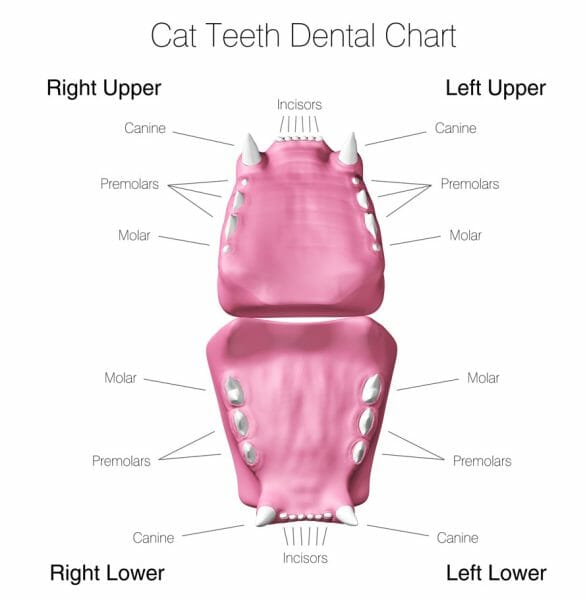
How Many Teeth Do Cats Have?
Many people wonder “do cats have baby teeth?” The answer is yes! When a kitten is still young, it will have 26 cat baby teeth. At the age of around 6 months, these will be replaced by 30 new adult teeth. As the adult teeth erupt, the baby teeth will be pushed out, and the cat will lose them.
A cat’s adult teeth are remarkably sharp as they are meant to be used to catch prey and chew food. Cats will also use their teeth to defend themselves against predators.
As the adult teeth begin to emerge, mild inflammation of the gums along with bad breath are common. These conditions will not typically affect the cat’s appetite and should resolve itself without intervention.
Each of the 30 adult teeth is attached to the feline’s jawbone and held in position using ligaments. Issues can arise when a kitten’s baby teeth do not properly fall out. When this is the case, an extraction may be necessary. In certain cases, a cat’s jaw may become overcrowded. This can occur when too many teeth develop. Problems such as this may be hereditary and may lead to cat gum disease.
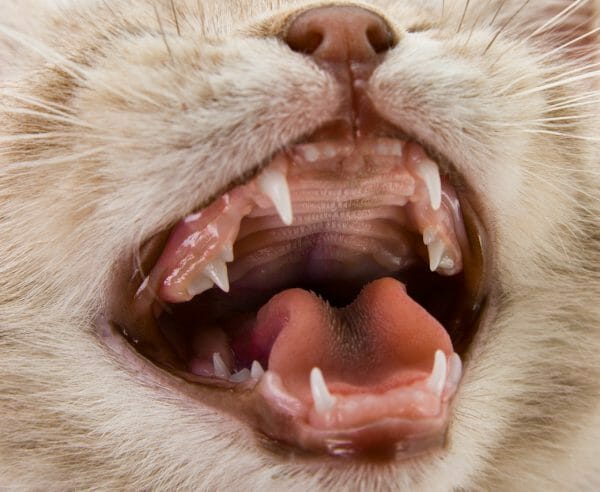
Common Cat Dental Problems
Just like humans, cat teeth can accumulate plaque and bacteria. If these are not removed, it will harden and form tartar, which will irritate the gums and cause gingivitis Eventually, cat gum disease may ultimately result in a cat losing teeth.
Severe dental disease in cats that is not properly dealt with will result in a build-up of bacteria in the mouth. This can, in turn, lead to further serious complications, such as kidney or heart problems.
The first symptoms of dental disease in cats are typically:
- Bad breath
- Yellow or brown tartar on the teeth
- Drooling
- Gums that appear redder than usual
When a cat is experiencing dental discomfort, it may chew on one side of the mouth. This makes it prone to dropping food as it is eating.
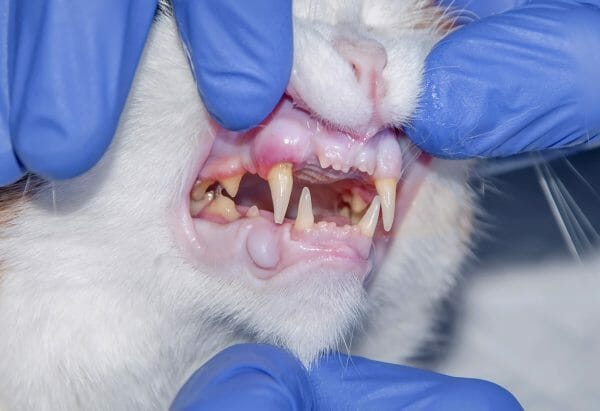
Cat Gum Disease
Periodontal disease refers to the weakening and inflammation of the tissue surrounding a cat’s teeth. Periodontal disease is caused by a build-up of plaque in a feline’s mouth. Pockets of bacteria will begin to develop around a tooth. This will eventually lead to the loss of the tooth if left untreated.
When a cat has excessive amounts of plaque, it can often be the result of the following:
- Defects of the immune system brought about by infection or illness
- The inability of the cat to naturally clean itself and its teeth.
These problems can be caused by disease, an accident, inflammation of the gums, tooth loss, or a change in diet.
How to Treat Gum Disease in Cats
Cat gum disease treatment will begin with the veterinarian cleaning the teeth below the gum line. This will be carried out under general anesthesia. When periodontal disease has become more advanced, tooth extraction may be the only option.
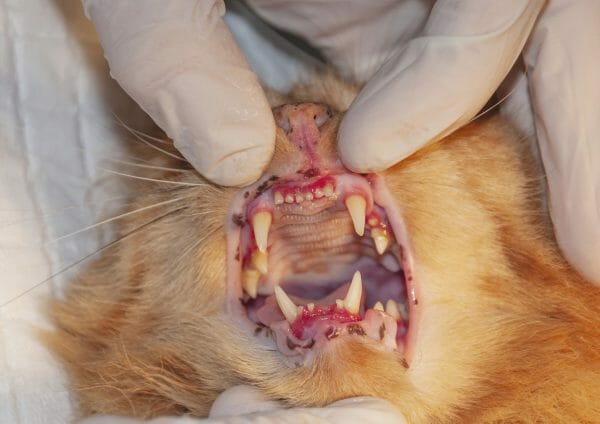
Do Cats Need Teeth Cleaning?
Many owners will ask “do cats need their teeth cleaned?” The answer is an emphatic yes. To maintain healthy teeth, it is important that a feline’s teeth are always kept clean.
The most effective way of reducing dental plaque and promoting good oral health is to brush a cat’s teeth every day. This will not only help reduce tartar on the cat’s teeth, but it will ensure the gums remain healthy while also reducing halitosis. Brushing a cat’s teeth regularly will cut down on the need for more expensive cat teeth cleaning appointments at the vet.
How To Brush Cats Teeth
If possible, brush a cat’s teeth once or twice daily. Regular brushing is the key to good cat dental care. When introducing brushing, do so gradually and take care to soothe the cat throughout the cleaning process. Ideally, a cat should become acclimatized to having its teeth touched from a young age. A veterinarian will be able to provide a demonstration of the most effective brushing technique to use.
There are plenty of cat teeth cleaning products available on the market. However, the most important will be a toothbrush. Where more than one cat is present in a household, a separate toothbrush should be used for each feline as sharing saliva can lead to cross-infections.
Cat owners should only use a special veterinary toothpaste. It is important that cats do not use human toothpaste as it can cause numerous problems. Experts suggest getting the cat used to the taste of the cat toothpaste by exposing it to the feline in small quantities.
In addition to brushing a cat’s teeth, introducing cat dental treats and cat teeth cleaning treats can help to promote good oral health.
Specially formulated dental cat food may be recommended by a veterinarian. In many cases, feeding a cat special dry food can help, as it can scratch off any plaque on the teeth. In addition, using a cat dental water additive may also be beneficial.
Chlorhexidine gels and mouthwashes are also available. These work to reduce the growth of bacteria in the cat’s mouth. However, prolonged use may lead to the tooth enamel becoming discolored.
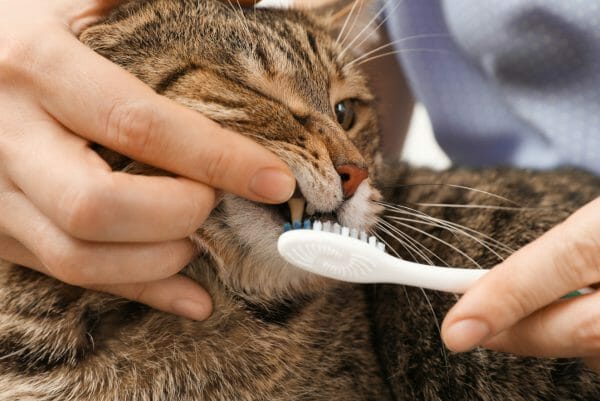
What Factors Predispose a Cat to Dental Disease?
When teeth are misaligned, they will be more prone to accumulating plaque and tartar. In these cases, the natural abrasion that helps to clean teeth while a feline eats will not take place.
Breeds that have abnormally positioned teeth include:
- Persians
- British and Exotic Shorthairs
- Chinchilla (a specific type of Persian cat)
In many cases, these breeds will have small jawbones that cannot fully accommodate all of a feline’s teeth. This results in overcrowding and misalignment.
In certain cats, deciduous teeth (also known as cat baby teeth) may remain after the eruption of the adult teeth. Where this occurs, the new teeth will grow at abnormal angles, causing misalignment.
Congenital abnormalities such as the shape of the jaw or traumas such as a fractured jaw can also lead to misalignment.
There are several different infectious diseases that are associated with gingivitis. Screening for feline immunodeficiency virus (FIV), feline calicivirus (FCV) and feline leukemia virus (FeLV) may be recommended.




